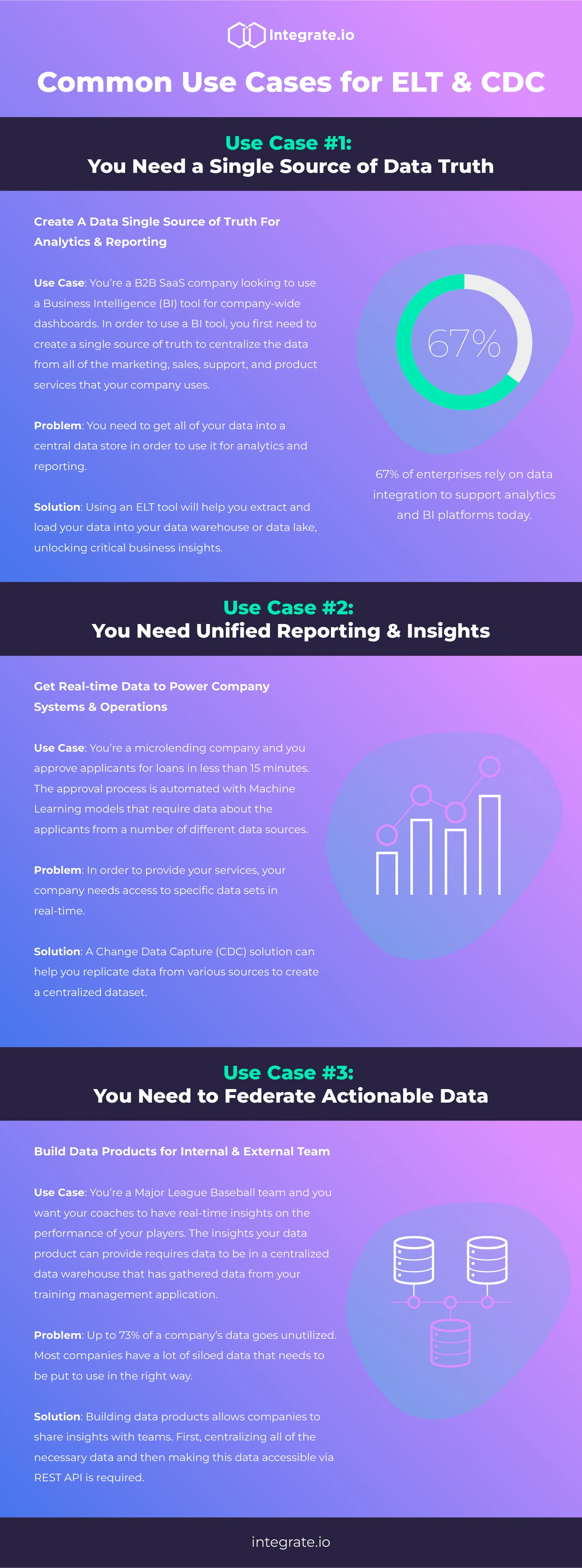Extract, load, transform (ELT) technology is a type of data pipeline that ingests data from one or more sources, loads the data into its destination (typically a data lake), and then allows end-users to perform ad-hoc transformations on it as needed. ELT can perform mass extraction of all data types, including raw data, without the need to set up transformation rules and filters before data loading.
This simple deployment makes it an attractive option for organizations, as you don’t need to go through lengthy data pipeline configurations before you can start data ingestion. You can collect all the data you have in one place, without worrying about its schema or format. Because you’re only transforming the data actually being used by the analytics and business intelligence tools, you can limit your compute capacity. The simplicity may seem like a big advantage, but ELT is very easy to outgrow.
Benefits of ELT
Several ELT features limit deployment complications, so you’re able to roll it out quickly.
ELT extracts and loads all data types: You don’t have to select which data you want to extract from your sources. You can pull in everything in any format, from unstructured data to structured, without needing to change it, which gives you access to raw, unaltered data.
Setting up the pipeline requires few decisions: An ELT approach typically only requires a few steps, and it may be as simple as setting the source and destination for your data. The rest of the configuration is already within the ELT tool, so you get a plug-and-play experience.
Data teams can decide on transformations later in the process: Your data team doesn’t need to figure out which data sets to transform until they actually need that information.
ELT Growing Pains
Simple isn’t always best, especially for data pipelines and analytics. You may run into ELT growing pains as your analytics becomes more mature and your data management becomes more complex. Here are a few of the biggest challenges you may encounter after deploying an ELT process:
Poor data quality: If you don’t limit the data that’s coming into your data lake, then you’re going to wind up with poor-quality data mixed in with the rest of the set. This data comes in many forms, from incomplete records to inaccurate information. When analytics solutions access this data for reports and visualizations, it can throw off the results significantly.
Lack of control over the data pipeline: ELT takes a general approach to handle data, so you’re not able to tweak the process based on a specific data type or pipeline requirement. You must address this lack of control later in the process, which can impact efficiency.
Data security issues: Few people in your organization need access to every data set in your data lake, so you’ll need to stay on top of access control for your ELT pipeline. Otherwise, unauthorized parties could view and use information they shouldn’t be privy to.
Sensitive data may not be compliant: Data privacy and access regulations may have compliance requirements that are incompatible with ELT solutions. The primary issue with ELT in these situations is that the sensitive data gets added to the data lake with no transformation, so it is vulnerable to exposure or unauthorized access before it goes through the transformation step.
Data sets become difficult to use: Data set sizes can quickly grow out of control when you’re collecting all available information. Managing this much data can become a challenge and make it more difficult to get value out of it. You also need to consider the data storage costs of full, raw data sets.
Waiting for transformations can lower productivity: Your data teams need to locate the data sets they want to work with and then wait for them to go through specific transformations for their analytics tools. This process can add a lot of downtime.
Multiple team members may run redundant transformations on the same data: Your analytics team may end up duplicating transformations and other work, which can affect their productivity.
Difficulty working with more complex data pipeline requirements: When you work with data pipelines that would benefit from more complex configurations, The ELT setup is limiting.
Why do Companies Consider ETL Tools Instead of ELT?
Extract, transform, load (ETL) solutions give you much more control over your data ingestion and transformation process, allowing you to create data pipelines perfectly suited for each type of data. You load only the data you want, in the formats you need, which reduces the administrative overhead associated with your data sets.
Data cleansing, enrichment, and data transformation all occur before data sets load into your target system, so analysts can immediately use this information once it reaches the data lake or cloud data warehouse. You configure data pipelines to work continually, so the entire process is standard. While you do need to set up new pipelines when you work with new target systems or data types, the ETL process permits advanced functionality that supports your organization over the long term.
You also receive a significant boost to your compliance efforts, since you can exclude or mask sensitive data before it loads. Unauthorized parties can’t look at data that doesn’t exist in the data set, after all.
Get Started with ETL and Integrate.io
Deploying ETL workflows in your organization doesn’t have to be much more complicated than ELT when you use the right tool. Integrate.io’s data integration platform delivers fine-tuned control over your data, a streamlined setup process, and a drag-and-drop interface suitable for everyone in your organization. Built-in data integration with over 100 data sources makes it easy to get more out of your data and data warehousing. Schedule a call with Integrate.io to discuss our 14-day demo.









